Thanks to the Forethought Foundation for providing research support during the creation of this post.
People are bad at naming things
When people ask what I’ve been working on and I say that I’m looking into declining global fertility rates, they sometimes think that I’m talking about rising rates of infertility. Which makes sense as an interpretation – fertility is a very overloaded term!
But the way that I (and most economists and biologists) usually use the term fertility is to discuss the rate at which children are actually born[1], rather than their potential for being born. Infertility refers to the inability of a heterosexual couple “to achieve a pregnancy after 12 months or more of regular unprotected sexual intercourse"[2]. So if there were widespread infertility in some group, this group would have low fertility rates, but low fertility rates are not necessarily indicative of widespread infertility.
Note that fertility in this sense is usually talked about on a population level, and there are different measures that try to capture different relevant features of it. Two popular measures of it are the total fertility rate and completed cohort fertility. See my discussion of those in my earlier piece here[3] .The term that gets closest to the opposite of infertility is fecundity, the “physiological potential to bear children”[4] or “the biologic capacity to reproduce”.[5]
Once I clarify that I’m working on studying the decline in the rate at which people are having children, I get the follow up question: but is some of the decline in global fertility rates due to a decline in fecundity and an increase in infertility?
TL;DR: Decreasing fecundity?
This is a tricky question to answer, because there isn’t one marker that can be used to evaluate fecundity, and so we have limited information on whether physical ability to conceive and bear children has changed over time.[6]
I won’t address all possible measures of reproductive health here, and will instead focus on sperm, because when the question comes up, people are often referring to the results of this paper: Temporal trends in sperm count: a systematic review and meta-regression analysis[7] (Levine et al, 2017) and the subsequent book by one of the authors on the paper, “Count Down: How Our Modern World Is Threatening Sperm Counts, Altering Male and Female Reproductive Development, and Imperiling the Future of the Human Race”.[8] The paper does not draw a connection between falling sperm counts and global fertility decline, but the book does, claiming that "the dramatic decline in sperm counts is an important factor in the fertility slump that’s being seen in many parts of the world".
My conclusion from reading the paper, skimming the book and looking through the related literature, is that:
- there is evidence of a decline in global sperm counts, but the data is less clear cut than is often implied
- Levine et al. meta-analysis finds decline, but has issues I will discuss
- the evidence for sperm count and quality declines is strongest among sperm donors and among those seeking fertility treatments
- there are very limited studies comparing different points in time that don't fall into one of those two groups, but the ones that I've been able to find all find no decline
- this potential decline in sperm count is unlikely to have been a substantial driver of the global fertility decline
- the Levine et al. paper finds a decline in sperm counts specifically among Western men, but the countries from which the Western sample was drawn already experienced most of their fertility decline by the start of the sample, at a time when, according to the paper, sperm counts were high
- evidence that age-adjusted rates of infertility for men are relatively flat
Sperm: Meta-analysis analysis
Headline results
The result that captured headlines in 2017 was that sperm counts had declined by 50% since 1970. Some of the headlines implied it was a global decline, but this is misleading: the results that the authors found was that it was specifically sperm counts of Western men in samples unselected for fertility that had declined by more than 50%.
This was calculated by aggregating the results of 244 studies since 1970. The raw values of sperm concentration and total sperm count are in the figure below.
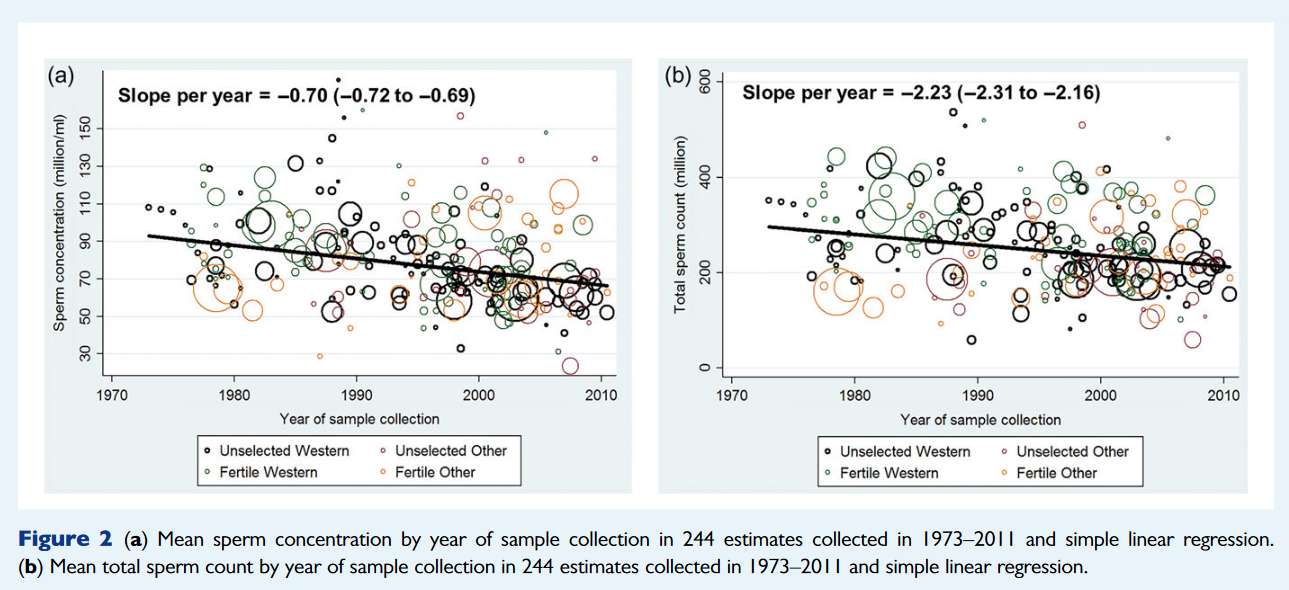
So the overall decline among all groups was more muted, with a decline of about ~30% in both sperm concentration and total sperm count.
Then, the authors control for more things and run a regression on each group (Western/Other)x(Unselected/Fertile), finding a >50% drop from 1973, the year of the first observation in this study:
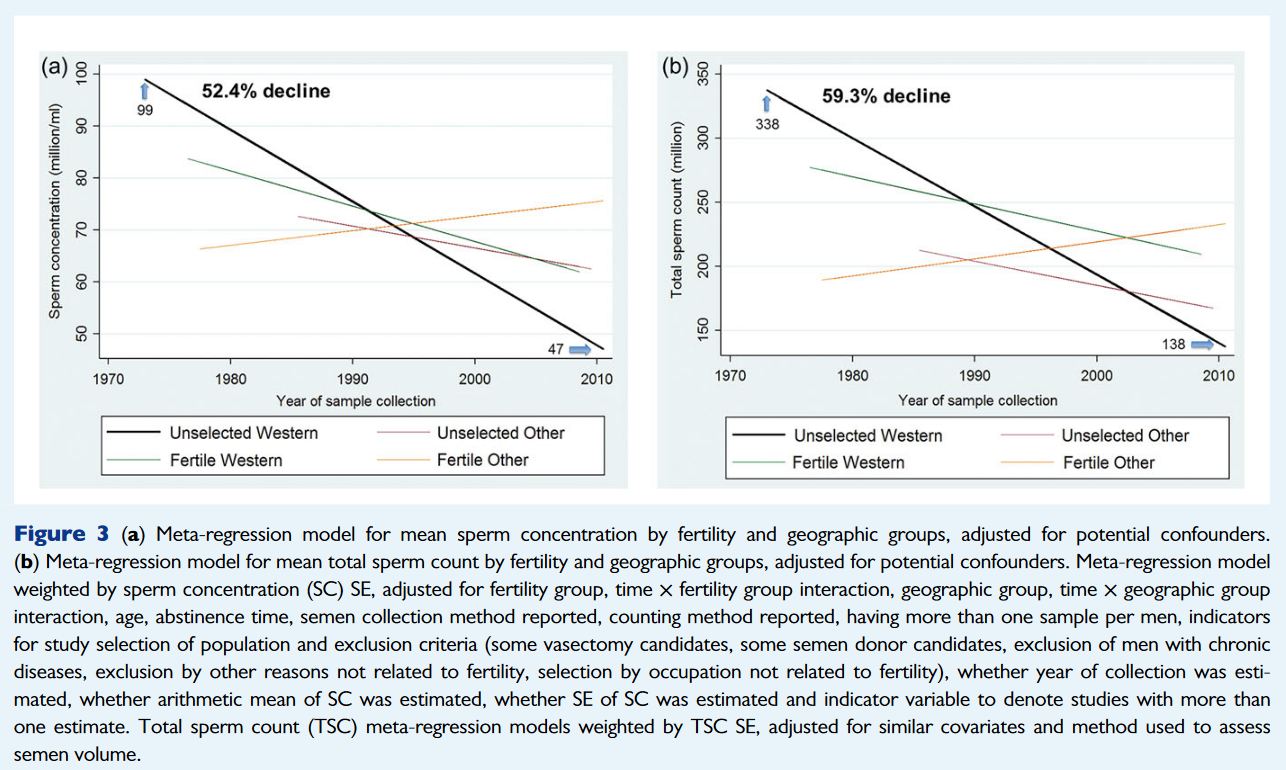
There’s a couple of confusing things about these results. In the 1970s, Western men unselected for fertility had 20% more sperm per ml and total sperm than fertile men? Why the different trend directions for the non-Western men depending on whether or not they were unselected? Some of the answer is that the data is noisy: neither of the non-Western lines is statistically significantly different from zero.
Why Western vs Other?
At some point in this explanation, you may have wondered why the authors chose to divide this sample into Western and Other. The answer is, I have absolutely no idea, they do not explain this decision anywhere in the paper. I'm additionally confused about the classification of Japan here, because I’m used to seeing Japan in the same bucket as Europe when dividing the world into more/less developed parts during the second half of the 20th century (while this is becoming an increasingly arbitrary classification, it did a better job of dividing up the world in a potentially relevant way several decades ago).
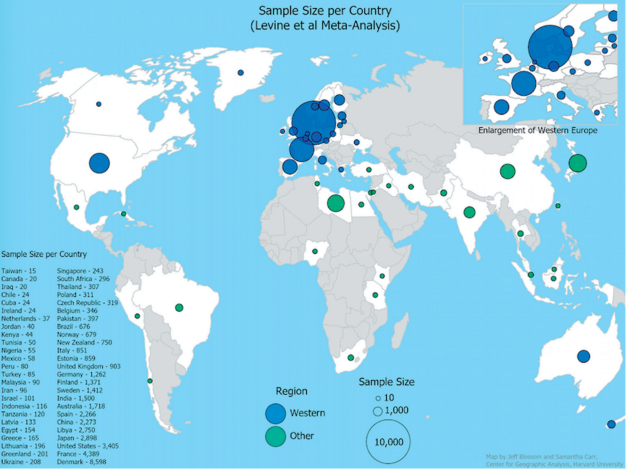
Though the authors don’t explain why they decided on this partition, one hypothesis might be that they expected the mechanism causing declining sperm counts to be more severely affecting the West. The paper doesn’t get too much into why this decline is happening, but gestures at “endocrine disruption from chemical exposures or maternal smoking during critical windows of male reproductive development may play a role in prenatal life, while life-style changes and exposure to pesticides may play a role in adult life.” In her book, Swan points at endocrine disrupting chemicals as being a primary culprit. Is there a significant difference along these dimensions between the West and the rest? I wasn't able to quickly find conclusive evidence in one direction or the other. In the appendix, I look at global rates of smoking, obesity, mismanaged plastic waste, and pharmaceutical river pollution. While there are regional differences, there doesn’t seem to be a consistent difference between the West and the rest along those dimensions.
Relationship to Falling Fertility
The best justification I can think of for partitioning the world into West and the rest is that it makes it extremely convenient for arguing that falling sperm counts are (thus far) unrelated to falling global fertility rates.
By the 1970s, when the Western sample had high sperm counts, Europe and North America had already completed most of their fertility decline, with average TFRs of 2.2 and 2 respectively for the period 1970-1975, dropping to 1.6 and 1.8 respectively by 2015-2020. These are declines of .6 and .2 births, about a ~25% and ~10% decline. If we started counting from 1975-1980, the drop would be even smaller: Western Europe and North America have essentially unchanged TFRs between 1975-1980 and 2015-2020. (Note that North America here is just the US + Canada, take it up with the UN, not with me. Also the US in particular had a slight rebound from a TFR of 1.8 in the late 70s to a TFR of 2.0-2.1 between 1990 and 2010.)
Europe in fact has had a bit of an uptick from the lows of the late 90s and early 2000s, years where the average European TFR was brought down by the fertility collapse of Eastern Europe that followed after the fall of the USSR.
In contrast, Africa (6.7->4.4), Asia (5->2.2) and Latin America (4.9->2.0) have all experienced declines of 2+ births between 1970-1975 and 2015-2020. These are higher decreases in both absolute and percentage terms. Asia, which is the source of most of the Other samples, had a TFR decline of more than 50%! Libya, the source of most of the samples from Africa, had a TFR decline of 70% from the early 70’s! (8.1->2.3)
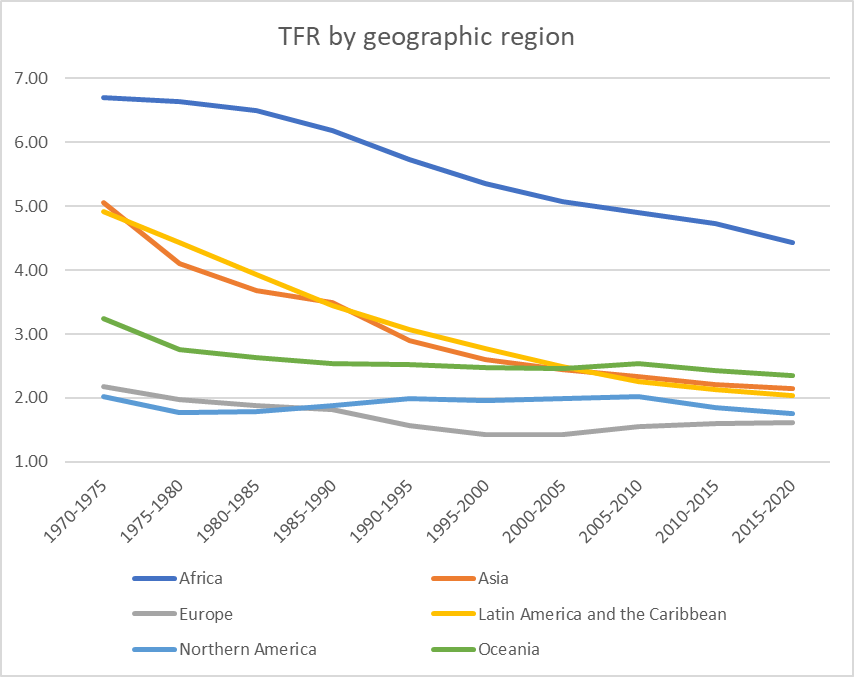
This graph makes clear how misleading some of the claims in the book are:
Worldwide fertility dropped by 50 percent between 1960 and 2015, and in some countries the decline has been even steeper. For example, between 1901 and 2014 the total fertility rate in Denmark dropped from 4.1 children per woman to 1.8 children per woman.
Denmark is not an example of a place that has had a steeper decline: comparatively speaking, the decline was relatively gradual, and there was virtually no decline over the period covered by this study! In 1970, when the meta-analysis found higher sperm counts among Western men than non-Western men, TFR in Denmark was ~2, and TFR bottomed out in Denmark in the early 1980s, at around 1.4, before rebounding a bit in the present.[10]
Note that these are total fertility rates. Completed cohort fertility rates for Europe (but not for the US) do show a downward trend over this time period.
As mentioned earlier, note that neither unselected or selected by fertility non-Western men had statistically significant declines in sperm concentration or sperm count: the 95% confidence interval for the slopes of those lines includes zero in all cases.
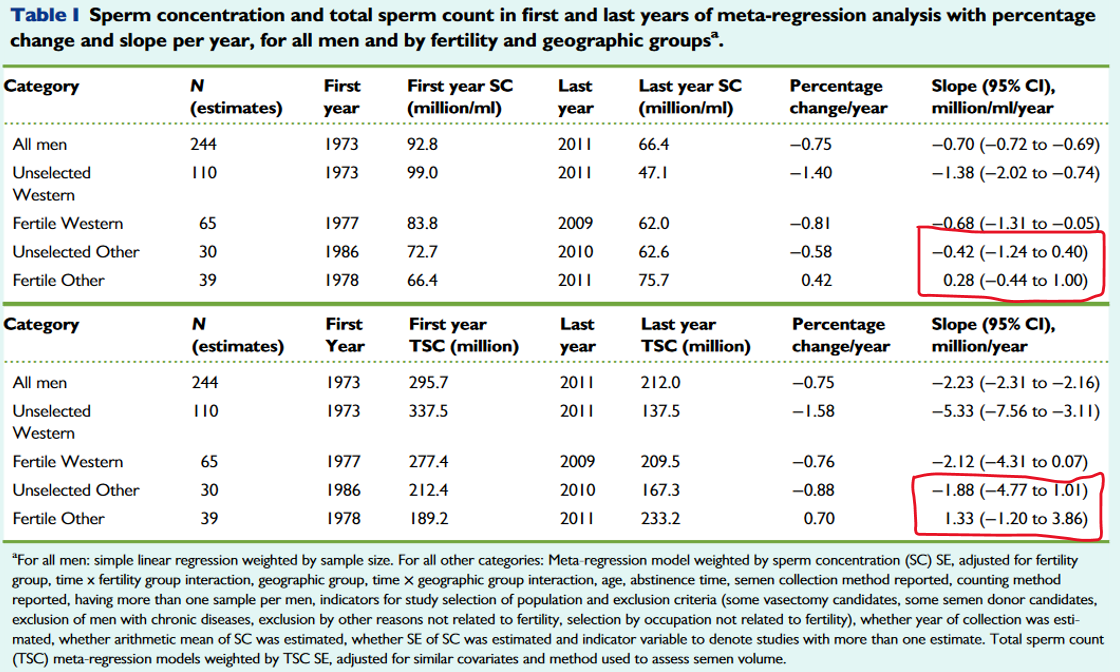
If we take these results at face value, steeply falling sperm counts are associated with roughly stable fertility rates, and stable sperm counts are associated with a steep decline in fertility! An important thing to remember about the global fertility decline over the past 50 years is that it is being driven not by falling Western fertility rates, but by the rest of the world catching up to (and in some cases *cough, South Korea, cough* passing) Europe and North America.
We can also see this gap in terms in world maps of TFR in 1970 and 2019.
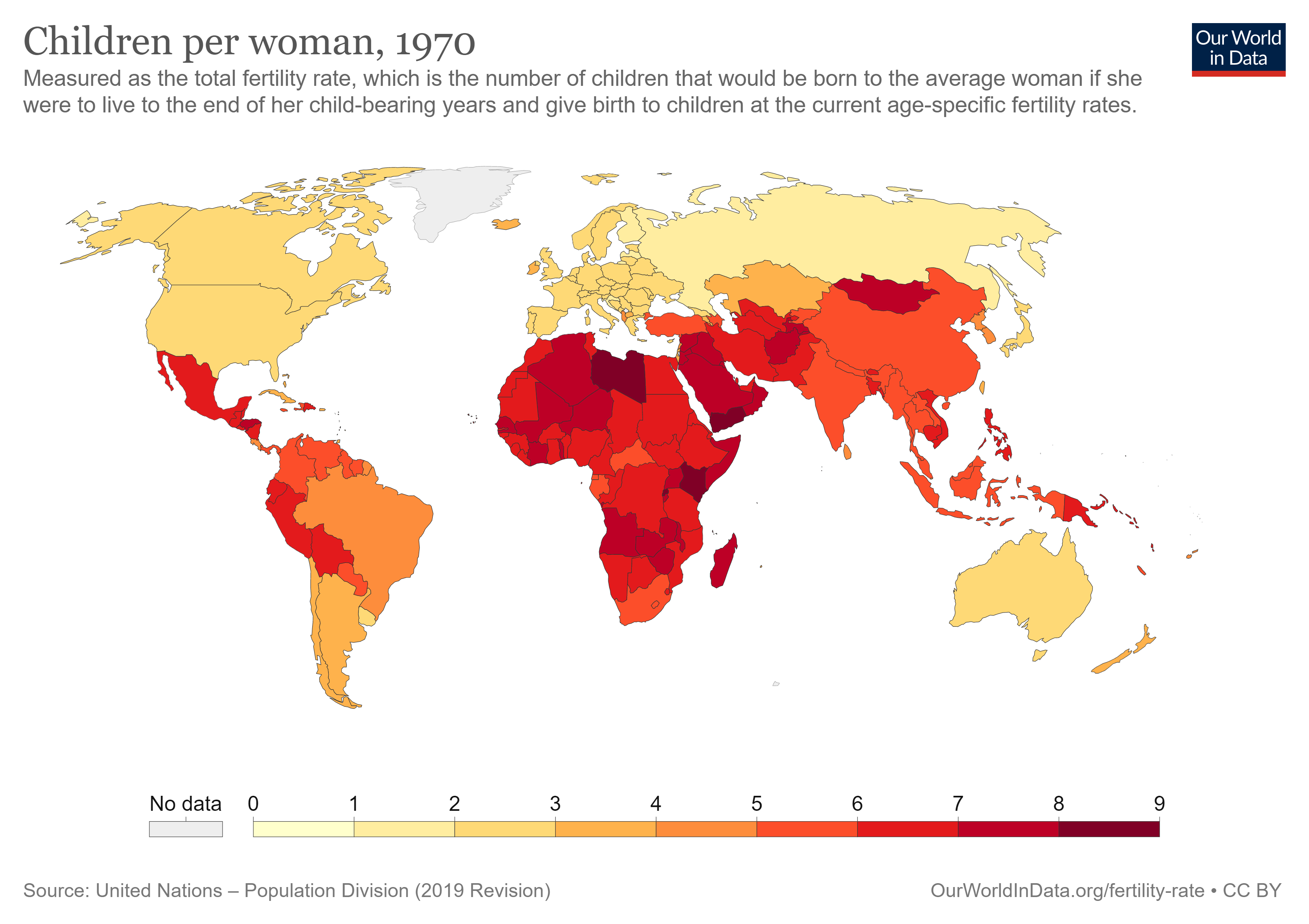
By 2019, most of the world is a similar shade to Europe, and all previously high fertility countries have experienced at least some decline:
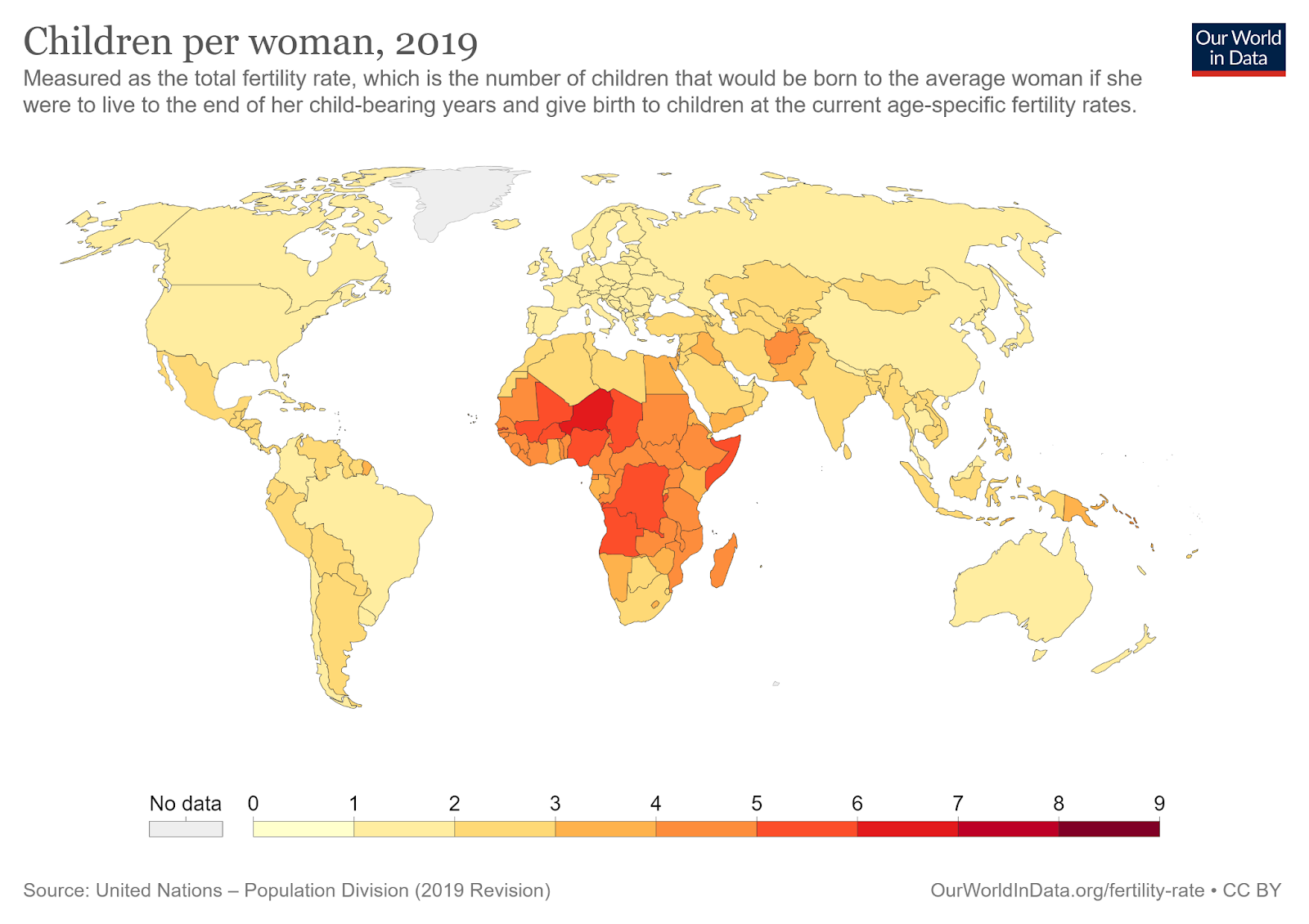
How about in the future?
Skimming the literature
While I’m very convinced that falling sperm counts weren’t behind the fall in fertility rates in the West over the period studied (1973-2011), because most of the fertility decline in the West was prior to that period, that doesn’t rule out the possibility that falling sperm counts will pose a problem in the future. So far, even taking the claims at face value, average sperm counts everywhere are still within the healthy range and not indicative of trouble conceiving [11]. But if the decline is real and it continues, this will eventually stop being true, and in the interim infertility will rise.
While I’ll confidently dismiss the claim that sperm counts (in the West?) are set to hit zero by 2045, as one of the authors of this study, Shanna Swan, claimed[12], does it seem to be the case that sperm counts are consistently falling globally?
To try to answer this, I wanted to see whether longitudinal studies were finding this decline, and not just meta-analyses of point in time studies. One criticism of meta-analyses was that the techniques for counting sperm have changed over time, even for studies nominally using the same tools, such as the haemocytometer [13]. Samples collected by the same lab over time would presumably have less of this issue.
While a handful of such studies exist, they show a wide range of outcomes, from no change over two decades (in Denmark) to a fifty percent drop in merely a decade (in China). The literature is just confusingly mixed (and sometimes astonishingly bad). One thing that I noticed was that studies on donor sperm often found drops while the only three studies I could find on men unselected for fertility that weren’t trying to donate sperm found no decline. Possibly the composition of sperm donors over time is changing?
This Danish study [14] was one of those three studies: 300 men a year for 20 years, participants unselected with regard to fertility status/semen quality. The study found no change between 1996 and 2016.
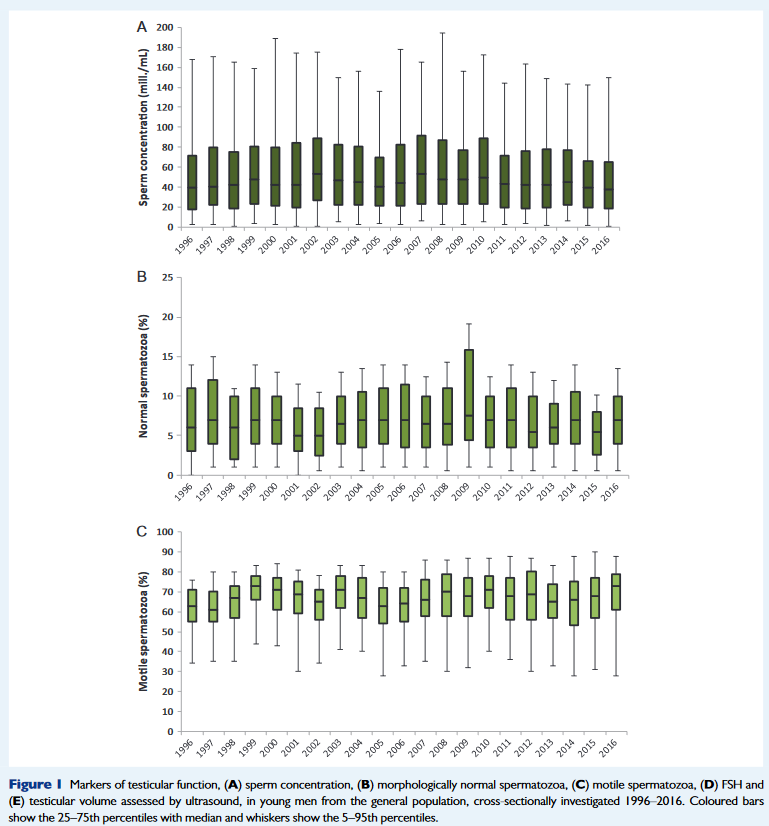
A study from Sweden which took two samples of 300 men, one in 2000 and one 2010, and found no difference between them in either concentration, volume, sperm counts or motility.[15] Another study from Japan found no change between 1975-1980 and 1997.[16]
There are also several longitudinal studies of sperm donors that do not find a decline, and in some cases studies find improvements: this study from Sydney between 1983 and 2001 found that total sperm count and ejaculate volume did not change but sperm motility increased. [17]
On the other hand, some of the longitudinal studies find extremely steep declines. This Chinese study of sperm donors, on the other hand, found the steepest decline, with a drop of 50% decline in 10 years (between 2009 and 2019). [18] Overall, it seemed that the studies in China found the steepest declines in sperm quality/quantity, often over a comparatively short time period, and often with much larger samples than other studies, though I couldn’t find any that weren’t sperm donors but were recruited via other means. Here’s a couple of others: Wuhan sperm donors from 2010 to 2015 [19] and Shandong sperm donors from 2008 to 2014.[20]
I’m stopping there, but I think it would be valuable for someone to do a meta-analysis of specifically longitudinal studies. While I believe that sperm quantity and quality did not meaningfully contribute to the global decline in fertility fertility over the past several decades, it seems possible that future declines in fecundity will contribute to declines in future fertility. The likelihood is difficult to assess given that the existing data has a number of issues. This demonstrates the need for better monitoring and for studies which recruit participants in a more representative way that just sampling men who choose to donate sperm.
Global Infertility
Another approach one can take on this question is to just check infertility rates directly. While there has been a slight increase in age-standardized infertility rates among men, it has not been large in magnitude, especially among men in countries with high social development scores.
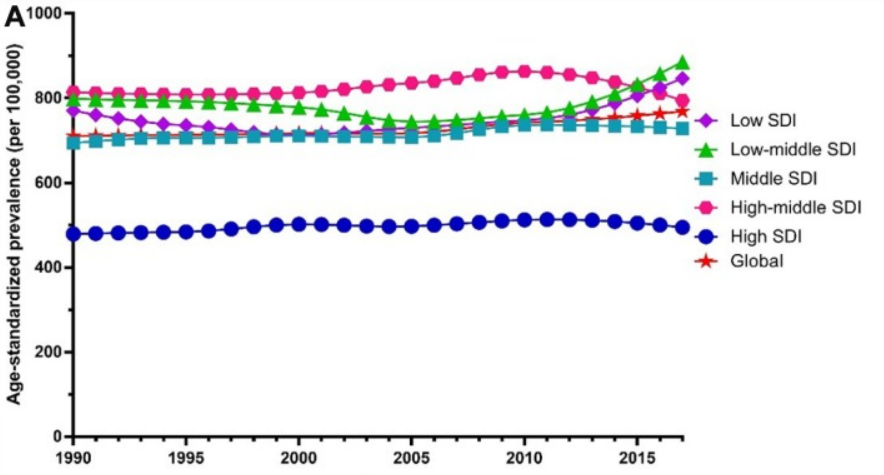
One caveat might be that it seems that age-standardized prevalence of female infertility has had a slight increase, and it seems possible that there is some misattribution of which member of the couple is infertile, and the uptick in female infertility is really an uptick in male infertility. But even so, there is not that much movement here, especially among high SDI countries.
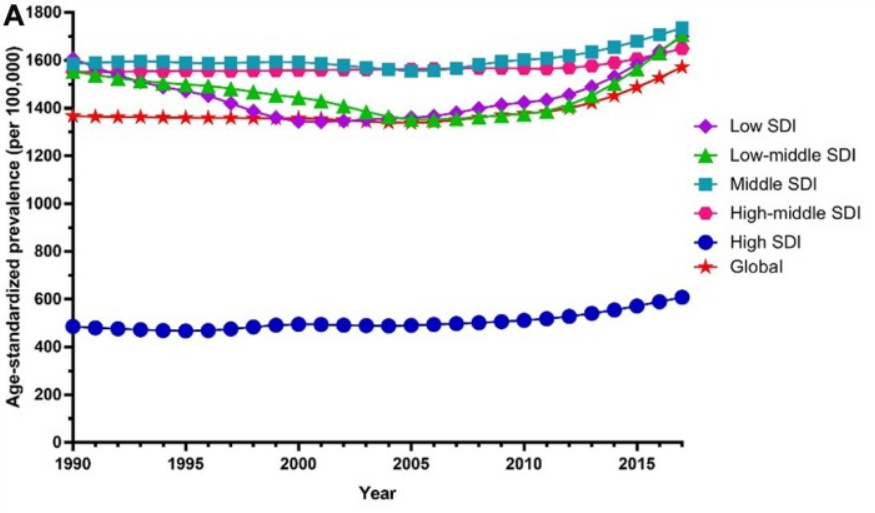
Other papers find a unchanged or even slightly decreased female infertility between 1990 and 2010. [22]
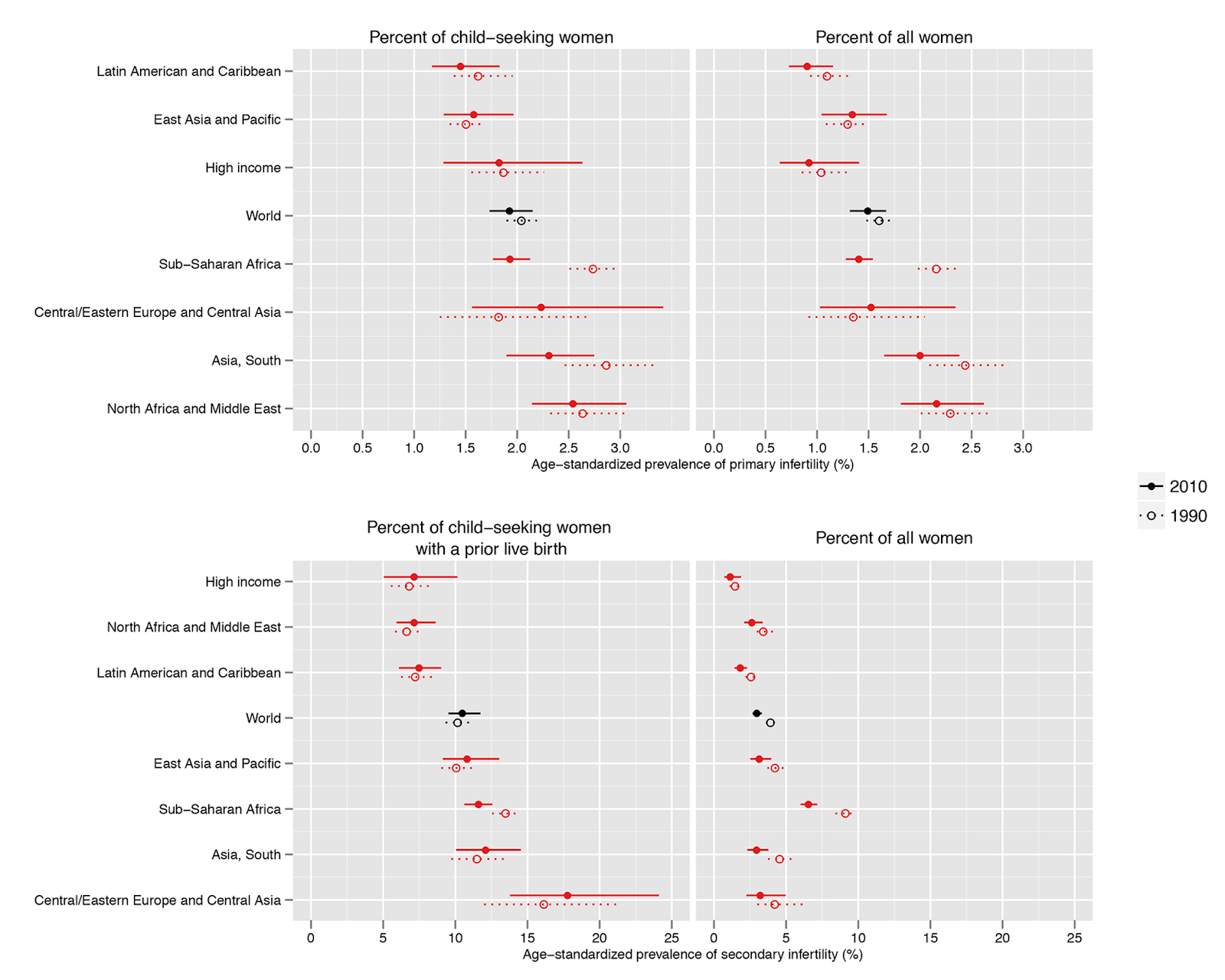
Note that spending on infertility treatments / assisted reproductive technology has been increasing [23], which I've seen cited as evidence of an increase in infertility. However, this increase in spending doesn’t necessarily mean that infertility is going up: it could be entirely explained by people being more willing to pay for treatment or because more effective treatments now exist (before the development of IVF, consumer spending on IVF was $0).
Appendix
Differences between the West and the rest?
As mentioned earlier, the Levine et al. paper did not provide a reason for separating the sample into Western and Other. One reason I could think of for why they might want to split the sample in this way would be if their hypothesized causes of the decline only affected the West, but a shallow skim of the evidence doesn't provide much evidence for this.
The share of adults that are overweight or obese is high in the West, but is also high in South America, the Middle East and North Africa.
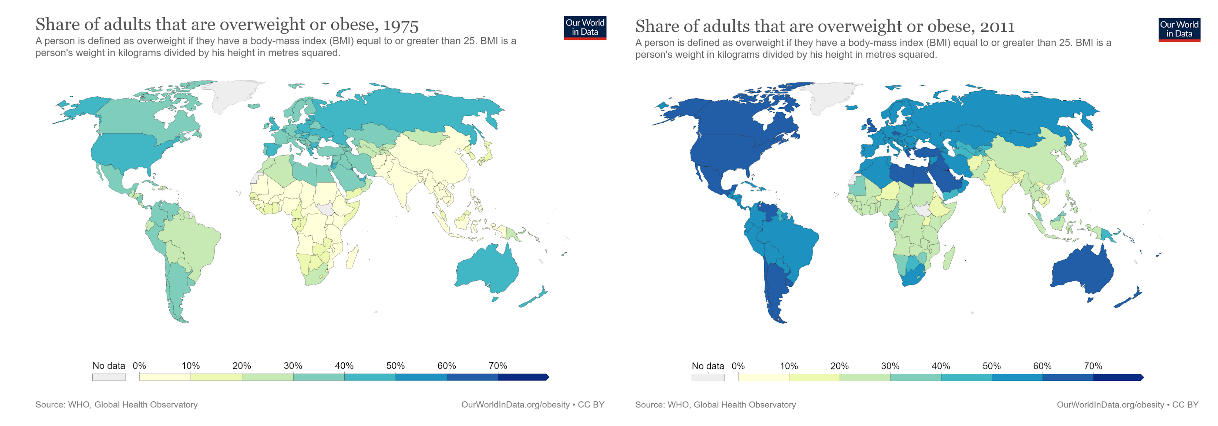
Smoking is also fairly geographically dispersed, and rates have been declining in both Europe and the United States over the past 50 years. [24] [25]
Though the West uses more plastic, plastic waste is more likely to be improperly disposed of in the rest of the world.
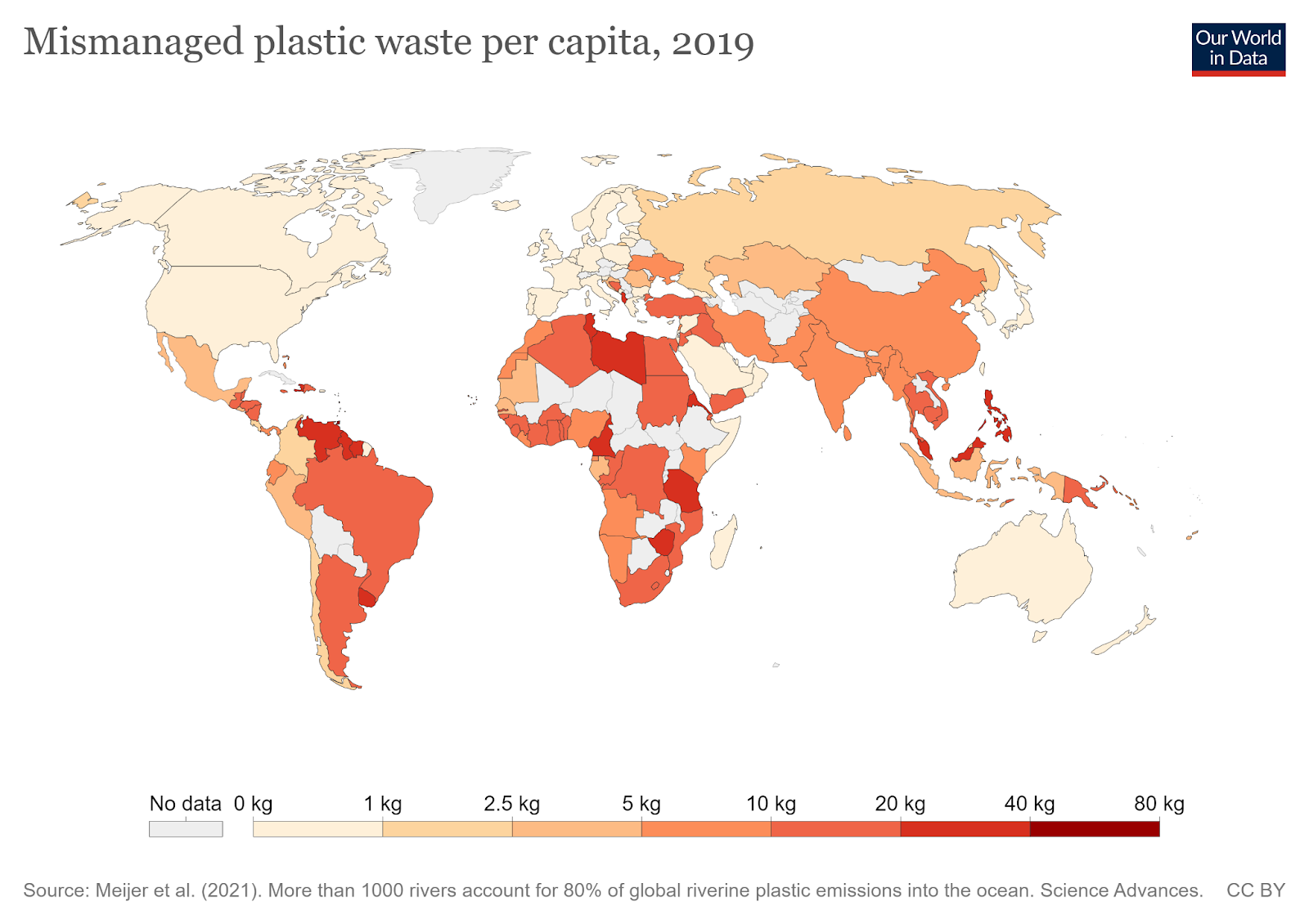
In a similar vein, the places with the most active pharmaceutical ingredients in rivers are non-Western. [26]
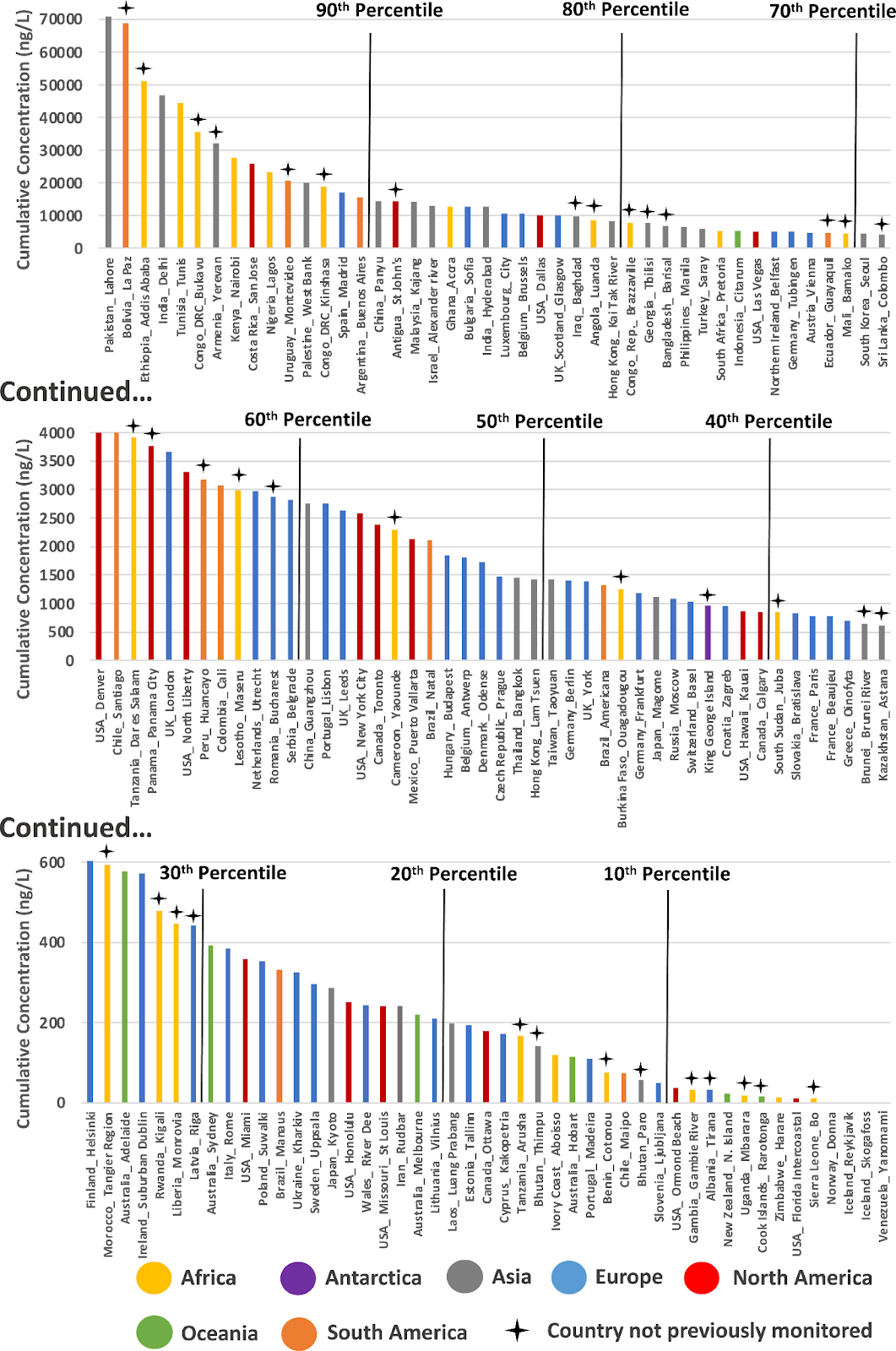
So overall, there doesn't seem to be a strong a priori reason to expect that any factor would be decreasing sperm counts specifically in the West, and so not much argument for partitioning the data in that way, though this did turn out to be very convenient for arguing that the sperm count decline didn't cause the fertility decline.
Previous and future work
So, in the last piece I wrote, I showed that many religious groups, including some in the US and Europe, had experienced falling TFRs over the past decade or two, while here I’m arguing that TFRs in these places have been low for almost half a century. Is this contradictory? Not really. Most of the highest fertility groups in the previous piece were sufficiently small groups that their fertility wasn’t making much difference in aggregate TFR even when it was higher.
Europe as a whole hasn’t had above replacement TFR for four decades, Western Europe for five. There’s been very little action in the Western Europe aggregate in particular, hovering around 1.6, +/- .1, since the late 70’s.
The US didn’t drop quite that low, and had bounced back a bit from the lows of the 70's, with almost-replacement average TFR throughout the 90’s and 00’s, before coming back down and setting new record lows these past couple of years.
The big difference between when the TFRs in some countries first fell below replacement and now is that now there is substantial evidence:
- that fertility rates aren’t going to increase on their own, and that fertility rates are difficult to raise substantially with just modest or even moderate subsidies (though subsidies targeting children do boost fertility!)
- that this isn’t just something about North America and Europe: Asia and Latin America are now also below replacement, and everywhere in Africa has started to see a TFR decline
In this piece, I addressed what hasn't caused the decline in fertility, rather than what has, because it's a multi-faceted issue which still doesn't have a singular answer, and I still don't understand enough to do the topic justice.
But to close with some relevant pieces to puzzle together: Some of the decline is from improved contraceptive methods, but most of Europe underwent the demographic transition well before the most used modern contraceptives existed.[27] Some of the decline is from changed preferences, but women in most developed countries have on average smaller families than their stated ideal family size.[28] Income plays a tricky role: at the global level, poorer countries have higher TFRs than wealthier countries, and within many countries, poorer families have more children than wealthier families, though this relationship has attenuated over time.[29] However, the causal relationship of income on fertility seems to be positive: positive wealth shocks increase the probability of having a child.[30]
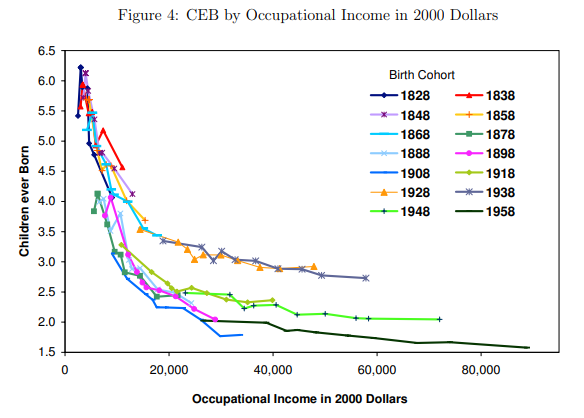

Another reason to doubt the infertility-->declining birth rate story is that some populations that live in similar environments have maintained very high fertility rates.
Ultra Orthodox Jews live close to other city dweller in the US, have high-ish levels of obesity (implying similar food environment to average westerner, which is a reason to think Amish living as farmers might be exempt), and have high fertility rates.
Also, there are some factors, like much better treatment of STDs, that should, all other things being equal, reduce infertility rates. Historically, STDs could be a major cause of infertility.
Also, the relationship between sperm count and conception rates is not linear. IIRC, after about 20 million/ML, higher sperm counts don't mean higher conception rates. So a 25% reduction in sperm count might not have much effect on conception rates for most men above that threshold, if that decline is even real.
(Apologies for the lack of citations, on mobile, will link later)
Thanks for this, isabel. I've only just become interested in this topic but your post is the second most useful thing I've read on it so far.
As for the most useful thing I've read, you say:
I'm more worried about declining sperm count eventually leading to (accelerating?) trouble conceiving globally after reading the abstract for the second study conducted by these authors, published in November 2022:
As an (in)fertility physician and ART (assisted reproductive technology) scientific researcher, I found this post fascinating. I agree with your conclusions - sperm counts may or may not be falling in some parts of the world, but unlikely to be contributing significantly to the decline in birth rates. This is also unlikely due to increasing rates of infertility. Most likely the decline in fertility rates is due to widely available effective contraception, increasing wealth, and increasing participation of women in the workforce.
The data also suggest that women are having less children than they ideally would like. I suspect the reasons are largely social ie lack of support such as paid family leave, affordable childcare, etc. But I wonder if there is also a biological component? I am curious about the impact of increasing age of first birth. It is well known that female fertility declines with age. I wonder if rates of secondary infertility (ie infertility while trying to conceive the second or third child) are increasing? I also wonder if making infertility treatment accessible to all and new innovative technologies, such in-vitro gametogenesis that would allow women of advanced age to have genetically-related children, would impact the birth rates significantly?